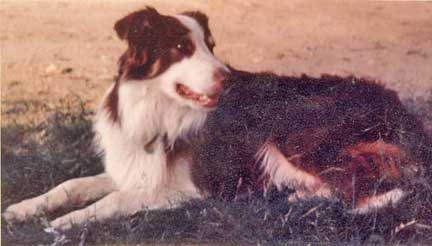

![]()
THE HEALTH OF THE BORDER COLLIE BREED

A girl feeding an orphan lamb (artist unknown),
with two gorgeous sheepdogs looking on.
The one in the foreground looks like a Border Collie type.
The one at the rear looks to be more of a bearded type.
Since there is no complete agreement yet among everyone concerned with the Border Collie, the herding breeders, the sports breeder, the show breeders, the registries, and even the vets, responsibility for the health of the breed is unfortunately still with the individual owners. It is clear, however, that the Border Collie as a breed is indeed subject to certain hereditary diseases. Testing for hereditary diseases is becoming more and more a reality, so that someday buyers will have the option of refusing to buy from breeders who have not tested their breeding stock for these diseases. Among the hereditary diseases is Collie Eye Anomaly (CEA), Progressive Retinal Atrophy (PRA), Hip Dysplasia (CHD), epilepsy and endocrine diseases. Allergies and skin conditions, and sensitivity to fleas or foods are also known, as are a variety of behavioral problems. Just recently a genetic study was begun on noise phobia in Border Collies. According to a preliminary report in Today's Breeder (Purina, issue 66, 2008) "the [early] analyses yielded multiple promising results" but that "noise phobia is a complex behavioral disorder and it is likely many different genes...may affect the overall anxiety of a dog and that this anxiety in addition to altered hearing acuity may result in noise phobia."

Above, a detail from Elegy In A Country Churchyard by Thomas Gray.
Progressive Retinal Atrophy (PRA)
A dog with PRA gradually loses its vision with age, and may appear normal until middle age. Therefore, there is a possibility the dog may be used in a breeding program before it becomes symptomatic. ISDS testing has reduced the incidence of PRA in Great Britain. According to the ABCA (American Border Collie Association, one of the three American Border Collie registries, and the most active and largest today) PRA does not exist in the United States, at least not in the Border Collie. Here is what the ABCA "eye committee" (which consists of Sally Lacy, chair, C. Denise Wall, PhD, Mellissa DeMille, PhD, and Amy Coapman, MS) has to say on the matter:
What was causing dogs to go blind 25 years ago was cPRA, or Central Progressive Atrophy. That disease simply collapsed of its own accord in the 1970's and 1980's. The geneticists who are at the cutting edge of retinal diseases are at Cornell and they have no proven scientific explanation, only speculation as to why. Because the disease disappeared relatively quickly, first in the USA and Australia, then the Continent and finally in the UK, they suspect it was an environmental problem, probably ending with the widespread use of commercial dog food which was fed to Border Collies in the UK some years after it was common in the US.
There is a condition that appears not to be genetic that affects working dogs, hard working dogs such as the field dogs and sheep dogs, which can be confused in the later stages with the retinas of breeds that are affected by PRA. Speculation here is that the retinal lesions are stress related and most commonly are seen in gung-ho young males that live and work where they can overheat. It is distinguishable from PRA in early phases by the fact that it is not bilateral, did not start as night blindness, and does not progress evenly and rapidly. Dr. Gregory Acland, who is doing the research on CEA, has followed up on the four young males he has seen (out of thousands) that exhibit all the symptoms of PRA. He examined close relatives (up to 30) to see if any others had similar degenerative retinal disease and found no possible genetic link. All those dogs listed by CERF as being PRA Suspicious are probably suffering from focal/multifocal retinal degeneration, and subsequent ophthalmic examinations show no progression, or at least not the progression PRA would take.
Despite the persisting impression that this genetic disease [PRA] is prevalent in the breed, extensive investigation has shown the incidence of PRA in Border Collies in North America to be extremely low to non existent. Therefore, the ABCA does not currently consider it a major health concern. Should true PRA be a problem in the future, the required examination of the eyes of all dogs which run in the National Finals Nursery and Open trials will catch it early on.

Above, detail from an illustration by Harry Rountree (1878-1950).
Since in most cases, PRA can be detected by the time a dog is two years old, why take the chance? Breeder responsibility and buyer vigilance can insure that lines are free from the disease. It is recommended that breeding be delayed until then. Breeding stock should be checked every year after that to be safe.
Collie Eye Anomaly (CEA)
Because CEA is recessive, parents that both have good vision can pass it on to their puppies. The lesions produced by CEA can be detected as early as six weeks old, so an entire litter of puppies may be tested, and eliminated from a breeding program if positive. If missed at six weeks, a dog can be tested, as with PRA, at two years old. There is now a simple genetic test being offered by Optigen which screens potential breeding stock for CEA. Go to Optigen and read more. There is also a good explanation of the effects of the disease on their website.
Hip Dysplasia (CHD)
CHD is on the rise in American Border Collies. It is a common misconception, even among some veterinarians, that a dog who is able to work must have good hips. Border Collies are often so engrossed in their work they can ignore pain. The Orthopedic Foundation for Animals (OFA) reports 16.9 percent hip dysplasia in the Border Collie, but since we can assume that in serious cases the X-rays were not sent to OFA, this percentage is slanted towards normal. X-rays may be taken of a Border Collie at two years old and sent to OFA for evaluation. Only dogs receiving OFA excellent or good should be considered for breeding.

Stop by and read the webpage of
WOOLGATHER MOSS, the editor's own epileptic Border Collie.
Epilepsy
Epilepsy, also known as seizure disorder, is a disease that cannot yet be tested for prior to breeding or in offspring prior to becoming outwardly symptomatic, and its inheritance has not even been currently proven. However, incidences of epilepsy are being encountered more and more frequently in the Border Collie, and, although the causes are not yet completely understood, it appears to run in certain lines. Breeding a dog with epilepsy is irresponsible and not recommended.
For more information on canine epilepsy
visit
EPILEPSY GUARDIAN ANGELS,
CANINE EPILEPSY NETWORK,

Above, a Border Collie head study by artist Libby.
Deafness
As with many breeds, sometimes an all-white or mostly white Border Collie can be born deaf, since hearing is somehow linked to the presence of pigment in the skin and more precicely, to pigment on the head and ears. This most often occurs with merle to merle breeding, which is why this breeding is discouraged. Usually dogs with some amount of color will not be deaf. Deaf dogs can make wonderful pets, and can even be taught to excel in sports such as agility and flyball. Visit deafdogs.org and familiarize yourself with living with and training a deaf dog.
Other diseases that may have a genetic component are skeletal problems, like Osteochondritis dissecans (OCD), and endocrine and immune system diseases. There are enough good working dogs available to breed from in the United States today, that it would not be responsible to the future of the breed, to the consumer, or to the reputation of the breeder to use a dog in a breeding program that is at all questionable, no matter what other stellar characteristics you think it has.
There is a Border Collie Health website of interest to Border Collie owners. It is maintained by Ronni DeLay of Majestic Border Collies. This website contains results of DNA testing for the CEA/CH (Collie Eye Anomaly / Choroidal Hypoplasia), CL (NCL - Neuronal Ceroid Lipofuscinosis), and TNS (Trapped Neutrophil Syndrome) genes in Border Collies. It gives a brief description of these inherited diseases, and then has lists of dogs with their registration numbers, their pedigree information and their assessment for the particular disease. It is of course only useful where particular owners have agreed to have the information about their dogs published. It would not be useful for statistical data since we don't know what percentage of the general population is represented nor what percentage of the negative results are represented. But if you are looking to buy a puppy from a particular breeding, you might want to look up the results for the parents on this website.
 VET TECH.COM - http://www.vettech.org/
If you are considering becoming a veterinary technician (vet teck) you are going to want to check out this website. It has a Guide to Vet Tech Schools, salary comparisons by location, information on financial aid, pet health tips, and more.
VET TECH.COM - http://www.vettech.org/
If you are considering becoming a veterinary technician (vet teck) you are going to want to check out this website. It has a Guide to Vet Tech Schools, salary comparisons by location, information on financial aid, pet health tips, and more.
Copyright ©2009 by Carole L. Presberg
THE OTHER WEB PAGES WE MAINTAIN
These web pages are copyright ©2013
and maintained by webmeistress Carole Presberg
with technical help from webwizard David Presberg
ALL RIGHTS RESERVED
If you are interested in using ANY material on this website, you MUST first ask for permission.